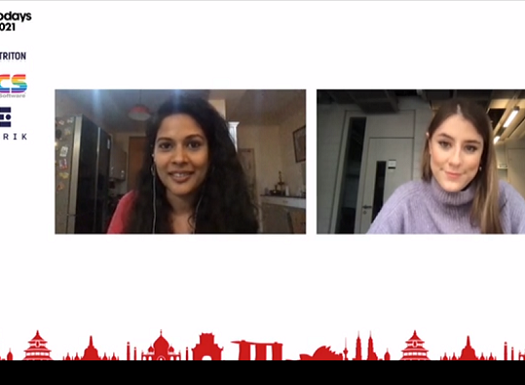Marianna Spring, BBC’s specialist disinformation reporter and Shruti Menon, Fact checker, BBC News Online, UK, spoke about the spread of anti Covid-19 vaccination online and its impact all over the world.
Marianna recently worked for an investigation about the issue of anti-vaxx, which has been going on since coronavirus vaccines began being rolled out in the UK before Christmas. What struck her was that there’s a big difference between the kind of conspiracy theories online, like the suggestion the Bill Gates, the Microsoft founder is trying to microchip you, or the idea that vaccines are going to alter your DNA; and understandable questions people might have about the vaccines – whether it’s safe, effective, how quickly it was developed.
The problem is that a committed of minority activists online are deliberately exploiting those questions in order to spread disinformation.
Her investigation started when a woman in her 80’s, who lives in UK, who had seen a video on WhatsApp that put her off having the jab. The video used people brandishing their medical titles and went on to spread disinformation. Marianna wanted to test if that video would work on different people and she found that out of a panel of eight who were shown this video, half of them felt more frightened about having the jab than they did before.
What helped one of the women affected by this was a Zoom call run by a local doctor to speak to the wider community about the fears they had. So, one of the ways to debunk misinformation is to speak to people through someone they trust in their community.
Another worrying thing is how this misinformation might affect younger people. There’s been a huge uptick in followers of accounts of anti-vaccine advocates, which are populated across the world by younger people.
Speaking about her experience in Asia, Shruti said, “the twist here is that religion plays an important role in South East Asian nations. So religious disinformation was rampant when vaccines were rolled out here, without confirming what the vaccine contains and how it works.”
In India, a largely Hindu majoritarian nation, a Hindu leader said people should not get the vaccine because it has cow blood serum. It’s not exactly misinformation, but cow blood serum is used in a majority of biological research so pandering to this information could stop people from getting the vaccine which is the most crucial at this point is harmful to the society. To prevent that, one should engage more with experts and fact-checkers.
Even before the coronavirus, there was a lot of misinformation in Asia, especially in India and Pakistan, about how Muslims had a role in further spreading coronavirus and making other communities more vulnerable to the virus. These are things that can be debunked with data, if not scientific expertise.
Marianna said that it is important to have a conversation about who is responsible for spreading misinformation about the vaccine. Its important to look at the role of social media sites – are they updating their policies and if so, how are they implementing it and governments – what legislations are they considering.
“But there is stuff that we can do right now to protect ourselves from this misinformation, which could cause harm to us. It is important to remember that disinformation often plays on your emotions, it is designed to make you react. Experts and scientists will always explain the risks involved in anything in a calm, level-headed way. What they may share online may not seem as eye-catching or attractive or as bad as information that makes you feel frightened, makes you fell like sharing with your family, or makes you feel angry or outraged for some reasons. So whenever you receive something, just pause for a second and think about the plausible consequences of passing it on if it’s not true. It’s also important to think about where that information is coming from. Is it a source you can trust? What else have they been saying? It’s also good to just speak to people who might be seeing this stuff and try to understand and address their legitimate concerns and worries,” said Marianna.
According to Shruti, you can just use your phone to check any image through Google lens to see if any images have been manipulated, or being used for propaganda, or to spread misinformation in a certain context. In Asia, most misinformation is old images recycled or manipulated to push a new narrative.
Marianna said: “Broadcast journalists have a huge responsibility to tackle misinformation through accurate and reliable reporting. It’s important for news and media organisations to have different people on teams who can do fact-checking, and be able to do that in a clear, concise way is really important. People want information in a way that is accessible and answers their questions quite simply. It it’s jampacked with jargon, they are more likely to turn off from it and turn towards bad information which can be easier to understand and very emotive.”
“It’s also important to have people in your teams who are tracking what is being shared online. They can identify who shares this stuff, where it’s being shared and the most prolific places for disinformation.”
“The most important thing is being able to weaponise the very things that allow this information to thrive in our reporting, so that the reporting itself is just as popular as the bad information that might have gone viral in the first place. The best way to do that is to humanise the impact of disinformation and conspiracy theories, by showing people who are affected by disinformation and how it impacted them personally.”
Shruti wrapped up saying: “Sensational news or fake news travels nearly 70 times faster than actual authentic news. So anything that you receive on social media, please be skeptical of it before you forward it.”


